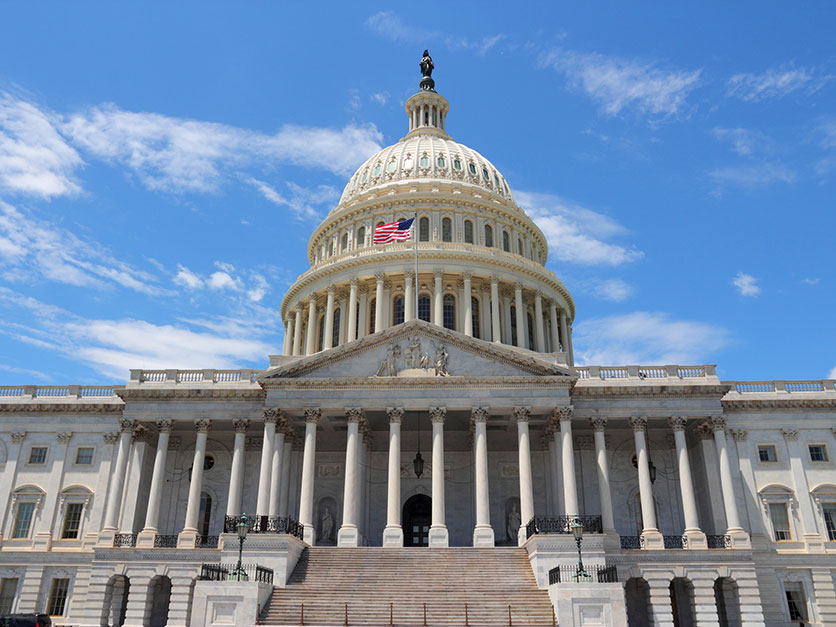A $2 trillion economic rescue package that congressional leaders agreed on Wednesday would replenish the Agriculture Department’s Commodity Credit Corp. authority and earmark additional money for livestock and specialty crop producers as well as local agriculture.
The additional spending authority would clear the way for USDA to make additional Market Facilitation Program payments this year. The package also includes aid for rural hospitals, direct payments to Americans and assistance for small businesses.
The 883-page bill would provide $14 billion to replenish the CCC account, which is capped annually at $30 billion, as well as $9.5 billion more for livestock and specialty crops, such as fruit, vegetables and nuts. Dairy producers and "local food systems" also would be eligible for the $9.5 billion, which is earmarked for producers harmed by the COVID-19 pandemic.
USDA used the CCC account to make the 2018 and 2019 MFP payments, and farm groups have been lobbying the administration to make another round for 2020.
The cattle industry had lobbied for direct payments to offset a steep drop in live cattle prices since January. The fruit and vegetable industry has asked for up to $5 billion to compensate distributors and growers for the loss of produce that could not be shifted from restaurants and feed service to retail outlets amid the pandemic.
USDA had asked for $50 billion in total CCC authority, Sen. John Hoeven, R-N.D., said earlier. It was not clear what the final number in the stimulus bill would be. Hoeven chairs the Senate Agriculture Appropriations Subcommittee.
The legislation also would extend the term of marketing assistance loans by an additional three months, from the current limit of nine months. The loans provide producers with interim financing so they don't have to market crops during periods when prices are relatively low.
Other key elements of the bill:
- $15.5 billion for the Supplemental Nutrition Assistance Program to cover an expected increase in demand as a result of the pandemic.
- $8.8 billion for child nutrition programs.
- $450 million for The Emergency Food Assistance Program, or TEFAP, which funds food distribution to food banks.
- $100 million for additional rural broadband grants through USDA's ReConnect program.
- $33 million to the Food Safety and Inspection Service to cover the cost of temporary and intermittent workers, relocation of inspectors and overtime costs.
- $25 million for the Rural Utilities Service to support telemedicine and distance learning services in rural areas.
- $4 million to cover the cost of repatriating Foreign Agricultural Service staff.
Zippy Duvall, president of the American Farm Bureau Federation, said the bill is badly needed by farmers. “The aid to farmers in this package, including funding for the CCC and the Office of the Secretary, will allow USDA to begin crafting an appropriate relief program for agriculture," he said.
Eric Deeble, policy director for the National Sustainable Agriculture Coalition, welcomed the inclusion of local food systems in the $9.5 billion aid provision.
“As a result of the ongoing COVID-19 crisis and ‘social distancing’ restrictions, we expect farmers who have lost access to direct markets – like farmers markets, schools, and restaurants – stand to lose more than $1 billion in sales this year. As the impact of the pandemic continues, their losses will mount and they will have to make hard choices about what to plant and whether they can stay in business at all," he said.
Interested in more coverage and insights? Receive a free month of Agri-Pulse or Agri-Pulse West by clicking here.
The stimulus package also includes direct payments of $1,200 per adult and $500 per child to low- and middle-income households as well as expanded unemployment insurance benefits, called Pandemic Unemployment Assistance; billions in aid to small business; and what Democratic Leader Charles Schumer, D-N.Y., calls a “Marshall Plan” for the U.S. health care system.
The direct payments to individuals would be phased down after $75,000 in adjusted gross income for an individual or $150,000 in AGI for a joint return.
Farmers who donate commodities to charity could deduct up to 25% of their value from their income, an increase from the current limit of 15%.
Rural hospitals will be eligible for help with their cash flow during the crisis. All hospitals can request an advance of up to 6 months of their Medicare payments equal. Critical access hospitals can get an advance of up to 125%.
The stimulus bill also directs the government to prioritize development of animal drugs to prevent zoonotic diseases — those that spread from animals to humans, as is widely suspected with the novel coronavirus. The 2009 swine flu pandemic had its origins in pigs.
Under the bill, drug sponsors can ask FDA to expedite applications for drugs that have "the potential to prevent or treat a zoonotic disease in animals, including a vector borne-disease" that can result in serious illness or death.
The overall package “will inject trillions of dollars of cash into the economy as fast as possible to help American workers, families, small businesses and industries to make it through this disruption and emerge on the other side ready to soar,” said Senate Majority Leader Mitch McConnell, R-Ky.
Download the text of the emergency appropriation section of the bill, including the USDA spending authority, here, and the full legislation, including tax and health care provisions, here.
Hannah Pagel and Steve Davies contributed to this report.
For more news, go to www.Agri-Pulse.com.


